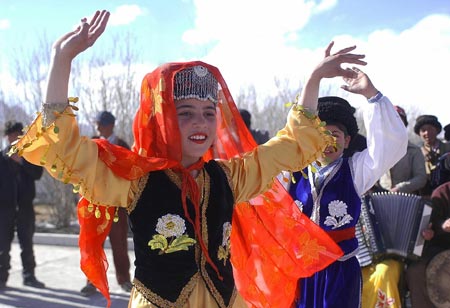The system of ethnic regional autonomy is a basic political system of China. Ethnic autonomous areas in China are divided into three levels, namely, autonomous regions, autonomous prefectures and autonomous counties. Now, China has established 155 ethnic autonomous areas, including five autonomous regions, 30 autonomous prefectures and 120 autonomous counties (banners). Of the 55 ethnic minorities, 44 have their own autonomous areas. The population of ethnic minorities implementing regional autonomy accounts for 71 percent of the total population of ethnic minorities. Meanwhile, China has established 1,173 autonomous townships in places equivalent to townships where ethnic minorities live in compact communities, as a supplement to autonomous areas. Of the 11 ethnic minorities for which regional autonomy is not implemented because their populations and habitats are relatively small, nine have set up autonomous townships.
 |
Tajik children are performing songs and dances. China has five provincial-level ethnic autonomous regions. The traditional cultures of ethnic minorities are fully respected and protected.
In accordance with the Constitution and the Law on Ethnic Regional Autonomy, the right of self-government of ethnic autonomous areas is fully guaranteed. They independently manage internal affairs of their ethnic groups in their autonomous areas, have the power to formulate regulations on the exercise of autonomy and separate regulations, and are allowed to use and develop their own spoken and written languages. The state respects and protects the freedom of religious belief of ethnic minorities. Regional autonomous areas also have the right to preserve or reform their own folk ways and customs, independently arrange, manage and develop the economic construction of the locality concerned, independently manage local revenues, and independently develop undertakings of education, science and technology, culture and sports.
The Constitution and the Law on Ethnic Regional Autonomy both stipulate that the state is legally obliged to assist ethnic autonomous areas in speeding up their economic and social development. The Central Government has consistently increased financial input and support to ethnic autonomous areas, attached importance to ecological and environmental protection in these areas, adopted special measures to help these areas develop education, science and technology, strengthened assistance to impoverished habitats of ethnic minorities, expanded appropriations in social undertakings in these areas, helped them open wider to the outside world, paired them up with more developed areas for support, and attended to special needs of ethnic minorities in their life and work.
After more than five decades of unremitting efforts, the conditions of subsistence in China's ethnic autonomous regions and local people's living standards have achieved remarkable improvement, amid rapidly developing economic and social undertakings in these areas. People living in ethnic autonomous areas and in other parts of the country are sharing fruits of the national modernization process. The successful practice of the system of ethnic regional autonomy proves it is a correct solution to China's ethnic issue, which conforms to national conditions and common interests of all ethnic groups.
Basic Facts of the Five Ethnic Autonomous Regions
|
Name |
Time of Establishment |
Capital |
Area (square km) |
Population at the end of 2006 (million) |
|
|
May 1, 1947 |
|
1,197,547 |
23.9235 |
|
Guangxi Zhuang Autonomous Region |
Mar. 15, 1958 |
|
237,693 |
49.61 |
|
|
Sept. 1, 1965 |
|
1,274,910 |
2.81 |
|
Ningxia Hui Autonomous Region |
Oct. 25, 1958 |
|
62,818 |
6.0373 |
|
|
Oct. 1, 1955 |
|
1,655,826 |
20.50 |










